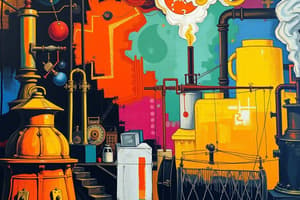Podcast
Questions and Answers
Who is credited with inventing the steam engine during the Industrial Revolution?
Who is credited with inventing the steam engine during the Industrial Revolution?
- Edmund Cartwright
- John Horne
- James Hargreaves
- James Watt (correct)
Which invention allowed for multiple spools to be spun simultaneously, improving textile production efficiency?
Which invention allowed for multiple spools to be spun simultaneously, improving textile production efficiency?
- Steam engine
- Iron plow
- Power loom
- Spinning jenny (correct)
How did the power loom impact weaving productivity during the Industrial Revolution?
How did the power loom impact weaving productivity during the Industrial Revolution?
- Had no impact on productivity
- Decreased productivity
- Increased productivity (correct)
- Caused a shift to manual weaving
What social impact did the Industrial Revolution have on working conditions?
What social impact did the Industrial Revolution have on working conditions?
How did the iron plow contribute to economic changes during the Industrial Revolution?
How did the iron plow contribute to economic changes during the Industrial Revolution?
What was one of the negative social impacts of the Industrial Revolution?
What was one of the negative social impacts of the Industrial Revolution?
Which economic change was a result of the Industrial Revolution?
Which economic change was a result of the Industrial Revolution?
What was a common working condition experienced by workers during the Industrial Revolution?
What was a common working condition experienced by workers during the Industrial Revolution?
Which technological advancement contributed to improved transportation during the Industrial Revolution?
Which technological advancement contributed to improved transportation during the Industrial Revolution?
What led to an increase in literacy rates during the Industrial Revolution?
What led to an increase in literacy rates during the Industrial Revolution?
Study Notes
The Industrial Revolution: Transforming the World through Inventions, Social Impact, Economic Changes, and Working Conditions
The Industrial Revolution, a period spanning from the late 18th to the early 19th century, marked a profound transformation in human civilization. This era, characterized by rapid industrialization and innovative technological advancements, significantly impacted society, economics, and daily life. Let's delve into these subtopics to better understand the scope and magnitude of this historical phenomenon.
Inventions
The Industrial Revolution was the crucible in which countless inventions were forged, enabling more efficient and productive methods in various industries. Some notable inventions include:
- Steam engine: Developed by James Watt, the steam engine revolutionized transportation and manufacturing processes.
- Spinning jenny: Invented by James Hargreaves, the spinning jenny allowed multiple spools to be spun simultaneously, improving textile production efficiency.
- Power loom: Developed by Edmund Cartwright, the power loom increased weaving productivity and reduced labor costs.
- Iron plow: Designed by John Horne, the iron plow made farming more efficient and allowed for larger acreages to be cultivated.
These inventions, and many more, set the stage for the profound changes that would follow.
Social Impact
The Industrial Revolution brought about a myriad of social changes, some of which radically improved the quality of life for many, while others introduced new forms of hardship.
- Urbanization: The Industrial Revolution led to the growth of urban centers as people migrated from rural areas to cities for employment in factories. This resulted in overcrowding, poor sanitation, and squalid living conditions.
- Improved transportation: The steam engine contributed to improved transportation networks, facilitating the exchange of goods and services, and enabling the rapid growth of cities.
- Improved literacy: The rise of factories and urbanization resulted in the establishment of schools, which led to increased literacy rates and fostered the growth of a middle class.
Economic Changes
The Industrial Revolution set the stage for unprecedented economic growth and changes in the global economic landscape.
- Advent of the factory system: The factory system, a method of production that harnessed the power of steam engines and new technologies, led to increased productivity and reduced costs.
- Industrialization: The Industrial Revolution spurred rapid industrialization, resulting in a shift from agrarian to industrial economies.
- Inequality: The Industrial Revolution led to a widening of the gap between the rich and the poor, as the wealthiest capitalists reaped the benefits of increased productivity and profits.
Working Conditions
The working conditions during the Industrial Revolution varied greatly, with some workers experiencing significant improvements, while others encountered new forms of hardship.
- Child labor: Children worked in factories and mines, often in dangerous and exploitative conditions.
- Long working hours: Workers were often required to work long hours in factories, mines, and other industrial settings.
- Poor working conditions: Workers, especially those in factories and mines, experienced harsh and unsanitary working conditions.
- Improved working conditions: As labor unions and activist groups gained traction, working conditions began to improve, with increased wages and reduced working hours becoming the norm.
Despite the hardships that many workers faced during the Industrial Revolution, the era set the stage for the modern world we live in today, with its technological advances, improved living conditions, and global economic growth. As we continue to explore and learn from the history of the Industrial Revolution, we can gain valuable insights into how our society can continue to grow and evolve.
Studying That Suits You
Use AI to generate personalized quizzes and flashcards to suit your learning preferences.
Description
Explore the profound transformation brought about by the Industrial Revolution through groundbreaking inventions, social impacts, economic changes, and working conditions. Delve into the era that reshaped human civilization and laid the foundation for the modern world we live in.




